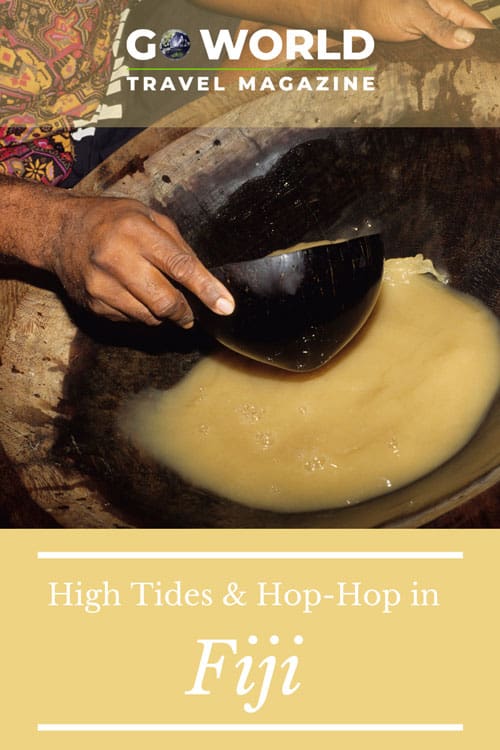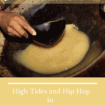
Editor’s Note: We’re all dreaming of travel ahead. Here’s some inspiration for future adventures. We share places, products and activities we recommend. If you make a purchase using a link on our site, we may earn a commission.
The Melanesian archipelago of Fiji sits in the South Pacific Ocean and spans over 300 islands and 500 islets, some 106 are permanently inhabited.

Fiji’s Viti Levu
It is here, in these innumerable island communities, that the nation’s heart and soul come to life – something which I had the privilege of experiencing first-hand in the highlands of Ra Province, on Fiji’s largest island, Viti Levu.
Whilst life in the capital city, Suva, is busy and increasingly metropolitan, a large portion of the nation is organized into smaller, more rural villages.
One of Fiji’s fourteen provinces, Ra occupies the north-eastern coast of Viti Levu and is made up of 93 itaukei (Fijian indigenous) villages. Its population totaling around 30,000. Within its borders lies Soa Village, where I spent the summer of 2019 living under the kind hospitality of a lady whom I came to know as “Auntie Bose.”
Her home, built largely from wood and corrugated iron, was painted pink with a stripe of blue lining its corners, windows and doorframes. Sitting atop a hill and overlooking the village, it felt strikingly majestic, a bright, colorful design suited perfectly to a family whose every step seemed laced with jovial spirits.
Owing to the kinship and community living that characterizes Fijian culture, this family was large, busy, and, by British standards, complex.

Family Dinner in Fiji
Family dinners, then, were no small affair. Auntie Bose would spread a blue blanket, or sometimes an old sulu (a traditional kilt-like garment), across the hand-woven mats lining the floor.
Atop this blanket would sit assorted bowls and plates of food to be eaten in a buffet-like style, typically ranging within the realms of stews, soups, noodle or rice dishes and, without fail, Auntie’s infamous tuna salad. The meal would be complete with a side of cassava and purple yams, both staple ingredients which the family grow themselves.
On one particular evening, each plate surrounding the blanket was topped with a singular fish. Its beady eye glared up from the plate as Mateo showed me how to reach the good stuff and, perhaps more importantly, avoid the bones.
Slowly getting the hang of things, Auntie Bose laughed and uttered a famed phrase: “See, Michelle, you would survive in the jungle.”
The fish soon devoured, I sent a vinaka naka kana (“thank you for the food”) in the direction of Auntie Bose and then leaned back onto the pillow behind me. It is customary – polite, even – to do so after a meal, laying back and resting with a full stomach and sated appetite.
In this space, this small gap in time where there was nothing to do but rest and talk, Auntie Bose and I shared stories, mythical tales or opinions on worldly events. Anything from university antics to jungle legends, to opinions on the British monarchy, were in the cards.
Such talks were fascinating and notably lacking in any sense of urgency, with no hurried panic to get the point across. Formed from calm, soft words spoken with the simple intent of sharing ideas, these honest and undistracted conversations remain treasured memories.

Kava Ceremony in Fiji
That night, we were heading down to a kava ceremony. Auntie Bose donned her rubber boots, but not before putting on a pair of statement earrings and a coat of dark red lipstick. She was wearing a pink, patterned jamba (a traditional two-piece garment worn by women) and struck a pose.
Her popularity within the community suddenly made complete sense, as did her youthful escapades come vividly to life.
The rubber boots, it turns out, were a wise choice. Though July and August sit within Fiji’s drier months, unusually heavy rainfall often turned the hilly descent from our pink house into a treacherous task. Auntie Bose’s children – Isa, Ili, Mateo and Malakai – ran carelessly and skillfully down without any fear of slipping while I walked tentatively behind.
Kava is the national drink of Fiji, known colloquially as “grog.” Made from the crushed root of the yaqona and strained with water, it has a mildly narcotic effect that induces a tingling, numbing sensation around the mouth and tongue.
Kava is served from a large communal tanoa, with each attendee brought, in turn, a bilo to drink from. The bilo itself is half of a coconut shell, filed down with a knife and buried underground for a few days until ready for use, at which point it is filled with the swirling, muddy-colored grog.
The kava ceremony was held in the bola bola, a make-shift construction to replace the community hall, which cyclone Winston obliterated in 2016. The aftermath of this brutal disaster, destroying almost 40,000 homes, was felt profoundly even three years later.
At the top end of the bola bola sat the village elders, including the Chief and Turanga-ni-Koro¸the head of the village.
Malakai, with his steady hand and dutiful demeanor, was serving the kava on this occasion. He brought a bilo toward me and waited until I clapped once, hands cupped to produce a loud and hollow sound. After this, I took the bilo from his hands and said a quick “Bula Vinaka!” before drinking the grog in one singular motion.
I handed the bilo back to Malakai, clapped three more times and watched as, beside me, Auntie Bose repeated the same ritual movements. As Malakai was leaving, he asked, “Tsunami?” He was making reference to one of the three servings that can be requested – low tide for a small serving, high tide for a full bilo and tsunami for a bilo that is practically overflowing.
Auntie Bose, mid-clap, looked at us and laughed. “Take it easy, Mala,” she said.
The ceremony carried on around us in this fashion, with attendees receiving their servings of grog and frequent cries of “Bula!” or “Vinaka!” filling the otherwise quiet hum of the night.

The Kava-Induced Celebration
Slowly, the evening loosened, feeling less ceremonial and more like the social celebration that kava is often used to induce.
A group of men brought out guitars and began to strum a light, upbeat tune, singing loudly to stretch their voices over the noise of conversation and laughter. And inevitably, as the music began, dancing did too.
The unspoken gesture of an outstretched hand pulled me into the frenzy of Hop-Hop, a traditional style of dance which, I was taught, has no real rules, moves nor sequence. It roots itself instead of in the act of moving freely, of loosely following the music and falling into a certain rhythm with your partner(s).
We weaved in and out of one another, spun around and shuffled from side to side until the music grew quiet. Vinakas were exchanged and then partners swapped, rarely allowing for a chance to sit back down and enjoy – or rather, gulp down – a bowl of grog.
The bola bola was open-air, yet it somehow seemed as though the subtle magic of living was contained by some invisible walls. Perhaps all of this was felt more acutely by me, a Westerner thrilled by a break from the digital habits of home.
Perhaps my intense, almost spiritual joy was the product of a departure from my usual worries, anxieties and stresses, dressing me with rose-tinted glasses through which to view something that, to the residents of Soa, remains entangled with their own day-to-day concerns.
Nonetheless, the positivity of the Fijian people is undeniable – warmth seeped right out from this scene, from the heart of the community, and into the night sky above.

Back into the Night in Soa Village, Fiji
Then, as we left the bola bola and scaled the muddy hill back to the pink house, it was this very sky that captured my own heart. Mateo pointed a finger to the clouds and I stopped in my tracks. Above me was a sky full of stars, so full that it looked as though it might burst from trying hard to contain its innumerable small, glowing dots.
It was like nothing I had ever seen before, and to this day, I still wonder if it might be the most beautiful sight I have beheld. Under this same assemblage of stars, Auntie Bose began to sing, “You picked a fine time to leave me, Lucille,” the song went, and, once again, my heart was skipping beats.
It was a song that my father had sung during my childhood, as he meandered the house, walked the dog, washed the dishes. From an Irish voice to a Fijian, everything felt suddenly perfect and acutely connected. I told her, excitedly, how my dad liked that song too.
There were the stars, the song, the sound of music, laughter and conversation growing softer as we walked away. But more than this, there was a sense of inner stillness. I became aware of my feet pushing against the ground, the night air against my skin, my heart beating and my chest glowing as it rose, then fell, rose, then fell.
Soa Village holds a particularly treasured space in my heart. There are not enough Vinaka Vaka Levu’s that I could give to that small corner of the earth.
Book This Trip
Reaching Ra Province from Nadi International Airport takes around three hours by car. The main urban center in Ra is Vaileka, more commonly referred to as Rakiraki town. Travelers should consult their accommodation provider if interested in the availability of village tours.
Find car rental options and exclusive deals from Suva and other locations around Fiji here. Be prepared with all your travel essentials like VRBO or hotel options, local food reviews, secluded beaches and more on Travelocity and TripAdvisor.
More hotels in the area include Wananavu Beach Resort, Dua Dua Beach Resort and Dreamview Villas Rakiraki. For solo travelers or those on a budget, The Beehive and Tanoa Rakiraki Hotel both offer dormitory, hostel-style rooms at a lower price. Alternatively, there is the option to camp at Namau Camp Site.
Author Bio: Michelle Grace is a student reading politics, sociology and Spanish at Durham University, exploring the implementation of culturally relative models of teaching and learning across the globe. She is passionate about empowering women to travel solo, as well as promoting ethical and sustainable ways of seeing the world. Michelle is currently living and teaching in Santa Maria, Paraguay.
- Discover Claremont, California Along Historic Route 66 - December 6, 2024
- Three Sites to Soothe the Soul in Kyoto, Japan - December 5, 2024
- 13 Essential Tips For Women Traveling in Morocco - December 4, 2024

